Journal of
eISSN: 2573-2897


Review Article Volume 5 Issue 4
Doctor of Historical Sciences, Leading Researcher, Institute of Archaeology and Ethnography, Russia
Correspondence: Andrew P Borodovskiy, Doctor of Historical Sciences, Leading Researcher, Institute of Archaeology and Ethnography, SB RAS (17 Academician Lavrentiev Ave, Novosibirsk, 630090, Russian Federation), Russia
Received: May 15, 2020 | Published: August 31, 2020
Citation: Borodovskiy AP. Artefacts of violence of the bronze and copper ages in the south of western Siberia. J His Arch & Anthropol Sci. 2020;5(4):156-165. DOI: 10.15406/jhaas.2020.05.00230
In the archeological sources, the facts of violent actions are expressed at several levels. They can include peculiarities of burial traditions, traumatic effects on paleoanthropological materials, objects symbolizing weapons and images of military conflicts. By now, there has been quite a variety of such facts revealed on the southern territory of the Western Siberia (Figure 1) for the Late Bronze and Early Iron Ages (1000 BC), which require detailed consideration. They encompass violence and peculiarities of burial customs; traumatic effects on paleoanthropological materials (cutting of heads, scalping, injuries); images of cut heads; objects symbolizing weapons; pictures of military conflicts.
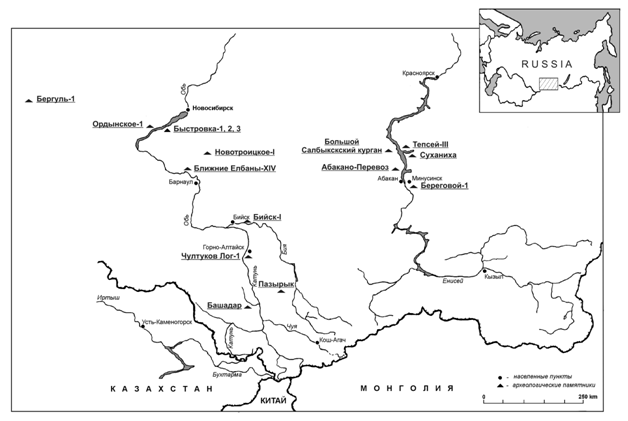
Figure 1 Map of violence artefacts distribution in the archeological complexes of the Bronze and Copper Ages in the southern part of Western Siberia.
Keywords: paleoanthropological materials, burial mounds, late bronze, early iron ages
Violence and peculiarities of burial traditions
In the Early Iron Age, depositions of representatives of “socially deprived” categories of the population are revealed in the elite and ordinary burial mounds of the Tagar archeological culture in the Middle Yenisei basin. In the central part of the Great Salbyk Burial Mound (Figure 2), a pair deposition was located, which was covered with birch bark. One of the buried people was placed with his/her face down. Another similar deposition was revealed in the southwestern periphery of the Beregovoy-1 burial mound (Figure 2,3). The buried person was placed in the twisted position, with his/her face down, on an ancient buried surface covered with the burial mound. There was no associated inventory in both cases. The buried people’s heads faced east, providing certain deviations from this direction (Great Salbyk Burial Mound). According to SV Kiselev, such burial places were forced depositions of captives or “patriarchal” slaves who were immolated in the course of traditional funeral customs implementation.
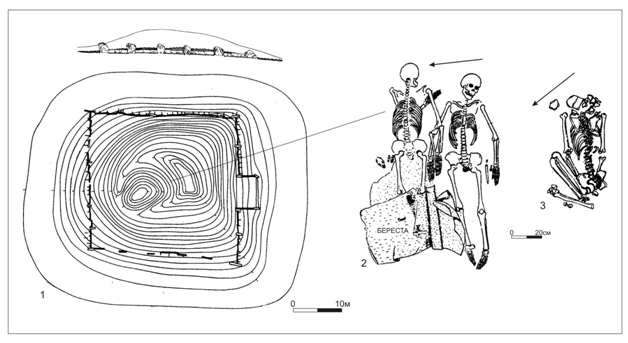
Figure 2 Depositions of “deprived” representatives of ancient groups in the elite (Great Salbyk Burial Mound) and ordinary (Beregovoy-1) burial mounds of the Tagar archeological culture in the Middle Yenisei region (Khakasia, Krasnoyarsk krai).
Traumatic effects on paleoanthropological materials
The traumatic effects on paleoanthropological materials related to violent actions can include scalping, cutting of heads and various manipulations with them, as well as instances of injuries characterized by clear-cut marks on bone tissues.
Scalping
Scalping as a way of obtaining high-value military trophies used to be widely popular, though on a case-by-case basis. The existence of the scalping custom for the territory of Western Siberia can be tracked for the whole set of sources: historical, folk, ethnographical and archeological. They encompass controversial mentions of scalping during the Kazym Rebellion of 1933,1 folk Mansi2 and Eastern Khanty, motives, several stories from the Ostyak heroic epos, indirect evidence of Minor Ioganka3 referred to the 14th century, effects of scalping on the skulls from the Second Pazyryk Burial Mound (5th-4th centuries BC) in Altai, Bystrovka-2 (6th-3rd centuries BC) in the Upper Ob valley,4 in the Saigatino 6 Burial Mound (10th-11th centuries) from the Middle Ob valley. The ancient descriptions of the scalping custom by Scythes5 referred to the middle of 1000 BC are usually commented by their analogues from any synchronous Pazyryk burial mounds with frost in Altai. However, in order to preserve accuracy of such parallels, one should consider an array of various details of this custom implementation by Scythes and Pazaryks. For example, Herodotus explicitly pointed out that “the Scythian warrior brought all the heads of those killed by him during the fight to histzar”. Afterwards, the head was skinned in the following way: “a small cut was made on the head, next to the ears, and then one took the head by the hair and shook the head out of skin”. Therefore, it dealt with scalping of the head that had been already cut from the body, providing that the hair coat should be removed to the highest possible extent, while the head of a scalped man from the Second Pazyryk Burial Mound was obviously cut off by robbers6,7 but not by those who scalped it. On the other hand, there are clear-cut differences in respect of the scalping technique described by Scythes and provided in the materials of the Pazyryk burial mounds. According to S.I.Rudenko’s observations, “the front skin was cut over the forehead from one ear to the other, through a standing out bit of hair, and stripped back”. It was related both to peculiarities of the hair-do and to the fact that the head was scalped without being cut off from the body. Therefore, it is hardly possible that the parallel descriptions of this custom provided by Scythes and natives of Gorny Altai can be regarded as similar.
In the burial mound of Bystrovka-2 of the Scythian time, three more authentic cases of scalping of buried people are recorded.8 In Burial Mound 1, Deposition 3, the pair deposition of grown-up men was characterized by clear-cut marks of scalping (Figure 3). Another secondary deposition with the marks of scalping was discovered in Burial Mound 2 (Deposition 2) of this cemetery (Figure 3). The skull and long bones of a young man (18-20 years old) were densely piled up (Figure 3). The man was likely to be buried in a bag or any other container when his bones had already lost their soft connecting tissues. There are certain similar analogues in some early Tashtyk burial grounds.9 The samples of calibrated radiocarbon dating (SOAN-3294, 3936, 3935) of the adjacent depositions (No. 8,11,13) of Burial Mound 2, Bystrovka-2 can be included into the chronological interval of 780-400 BC, 760-390 BC, 810-540 BC.10 These data allow considering Deposition No.2 from Burial Mound 2 of the Bystrovka necropolis characterized by the marks of scalping a complex dated from the Scythian time.
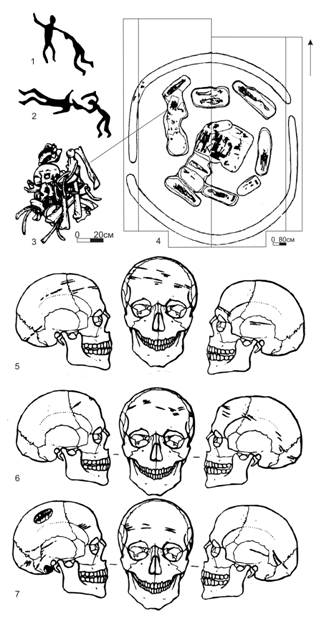
Figure 3 Facts of scalping in the Early Iron Age on the territory of the southern part of Western Siberia.
3-7. Facts of scalping (Bystrovka-2, Burial Mound 1, 2);
1,2. the Middle Yenisei region;
3-7. the Upper Ob region.
Besides the scalping cuts, the skull of the second skeleton from Burial Mound 1, Deposition 3, possessed the marks of military injuries. They were represented by the marks resulted from two slashing blows dealt at the surface and base of the skull of the right side of the head. The stroke marks on the parietal part were viewed as a long cut of 3.5 x 2.6 cm, with the bladder grazing 3-4 mm deep into the compact substance of the skull bones (Figure 3). Another blow was dealt at the mastoid bone of the right temporal bone. It found directly the nuchal line where the boundary between the neck muscle insertion and hair growth start line lies. That blow was obviously delivered from behind for the purpose of cutting the head of the body before scalping, which is confirmed by similar cases described by ancient Scythes. Other two skulls do not possess any marks of head cutting, which could be preserved directly on the bones. However, taking into account the recurrence of Deposition 2 from Burial Mound 2, this possibility should be ruled out.
On the whole, the consequences of scalping on the buried skulls from Bystrovka-2 are represented by a set of cuts. Their length varies from 1 to 1.5 cm, and their depth – from 1 to 3 mm. They create a number of lines located on the frontal, temporal, and parietal bones of the skull (Figure 3). By the way, the younger a buried person is, the longer those cuts are. It can be correspondingly tracked on the skulls from Burial Mound 2, Deposition 2 (18-20 years old) (Figure 3) and Burial Mound 1, Deposition 3–Skeleton 2 (25-30 years old) (Figure 3), Skeleton 1 (45-55 years old) (Figure 3). Such a peculiarity can be determined by age characteristics of distribution and density of the hair coat. It may be the reason why the oldest scalped person (Burial Mound 1, Deposition 3, Skeleton 1) has the shortest and shallowest cuts on the skull. One should also point out other peculiarities of the mere cuts on the skull bones. Judging by their depth (0.3-1 mm) and presence of burrs in the top edge of the cuts, one can form a certain idea of the mere scalping technique. The deep penetration of the bladder into the bone tissue is determined by its fresh state.11 Simultaneously the top location of notches on the cut testifies to the fact that the bladder was moving bottom upwards or from the right to the left while hair was pulled on during the scalping process. The burrs on the cuts are located on one (top) side, which was determined also by the turn of the victim’s head in the course of scalping. It also caused a double half-spiral line covering all the surface of the skull bones from Bystrovka-2. Therefore, such peculiarities just underscore the fact that one scalped a cut head that was easy to get with. The similar method is mentioned in the Ostyak heroic epos of the middle Ages. One should point out one story out of several legends related to the winners’ intent to remove the head skin “ukh-sor” from their enemies’ skulls. The author tells us how the head of the Samoyedic Prince, Sos-Turum, which was cut by the Ostyak strongman, runs away from him trying to preserve its scalp, i.e. “rainbow coloured head skin”. Therefore, the most recent mythological motives are provided with a certain factual confirmation from the archeological sources.
Another source of information related to many issues of the Siberian ancient history is represented by rock paintings. Recently, there has been an entire array of specialized works related to reflection of certain sides of the material, spiritual, and military culture of the ancient population of Southern Siberia. One of them is a publication by OS Sovetova devoted to possibilities of use of rock paintings as sources of military arts of the tribes of the Tagar epoch. It deals with separate compositions of Kunya and Abakano-Perevoz, which are interpreted as an image of how to grab the enemy’s hair during a fight. In our opinion, such compositions can be also related to the scalping practice. The historical background, with which the cases of scalping known from the archeological sources are associated, is also no less interesting. While for the Pazyryk burial mounds the example of such a tradition is indirectly related to the consequences of the Greek and Persian wars or the period of instability in China, the burial mound group of Bystrovka-2 is likely to be associated with the expansion of Alexander the Great to Central Asia. Undoubtedly, such historic events provided a global impact on Western Siberia and the whole of Eurasia. It is indirectly confirmed by the appearance of images of war elephants not only among imported items (the Siberian Collection of Peter the Great) but also in the decorative components of the warhorse dressing (Ob’ezdnoe-1).12 The dynamic events of that time could probably provide another impulse for side-spread occurrence of many specific military customs related to the heads of the defeated. In that historical situation, the south part of Western Siberia along with Black Sea Scythia is included into the set of territories where this tradition was quite popular.
Cut off heads
In the second part of 1000 BC, Herodotus mentioned the Scythian custom of justice with relatives implying that once the “trial” was over, the head of the guilty person was cut off. The traitors were treated by Scythes in the same way. For example, Tsar Scyles who flinched from the Scythian customs shared the same fate. The archeological materials of that epoch also contain evidence of such a custom. In the Kurdjips burial mound of the 4th century BC from the Kuban valley, there is an image of warriors holding cut off human heads by the hair on the golden cap.13 The Scythes, Sarmatians, Huns14 regarded the enemy’s head as an honorary military trophy. According to V.I. Ivanov, various manipulations with cut off heads in 1000 BC are likely to trace their origin to certain Eastern and Mediterranean female cults related to orgies. In Central Asia, the cut off human head was one of the attributes of the ritual activity and political culture up to the High Middle Ages. In the southern part of Western Siberia, the discovered depositions of skulls are referred to the period from the Intermediate to Late Bronze Age (2000-1000 BC). The depositions of several dozens of skulls are recorded in one of the Krotov-Elunin graves. The depositions of skulls are known also in the Samus burial mound in the north part of the Upper Ob valley. The depositions of the Irmen burial mound of Kamen-1 in Bolotinsk district of Novosibirsk region include a deposition of a human skull with a vessel under the stele. In the center of Burial Mound No.6 of Sapogovo-1, which is referred to the Late Irmen period and located in the Kuznetsk depression, one discovered skulls of three men, whose eyeholes faced different directions. Separate depositions of human heads are known in the sanctuaries of Western Siberia of the Early Iron Age, on the territory of ancient settlements of the Middle Irtysh valley – Bolshoi Log15 and the Middle Ob valley – the ancient settlement of Sarovskoe. These depositions were as a rule supplemented by ceramic vessels.
On the western edge of Burial Mound 9 of Bystrovka-2, at the daylight surface level, there is a separate deposition of the heads of two young women and one man (20-25 and 30-35 years old correspondingly) recorded. The skulls were located together with ceramic vessels associated with other foreign (Kulai and Sargat) cultures (Figure 4). This adjacency is hardly accidental as when offering human sacrifices one frequently gave “preference” to foreign tribe representatives. For example, one of women’s skulls of Burial Mound 9 of Bystrovka-2 characterized by explicit taiga features was located next to a “forest” Kulai ceramic vessel of an obviously northern origin. According to the Siberian ethnic groups, the victim’s head played one of the main roles in the rituals. Thus, Selkups regarded the head as a temporary vessel for a grave soul–kedo, which could not leave a late person’s body until its corpse was, destroyed. Nganasans associated a brain or eyes with the soul. The ethnographic materials contain the evidence when certain skull manipulations were meant to facilitate the soul removal. According to some evidence, this method was used in Tuva when burying very old people. Their head was broken through. All these ethnographic parallels could possess not only an illustrative and comparative character for the deposition of skulls of the Bystrovka necropolis (Burial Mound 2, Bystrovka-2), but also a more profound meaning. The matter is that the broken bones of the skulls in the basis of eyeholes and trepanation of the skull base were obviously meant for removal of eyes and brain of the dead (Bystrovka-3) or immolated people (Bystrovka-3).
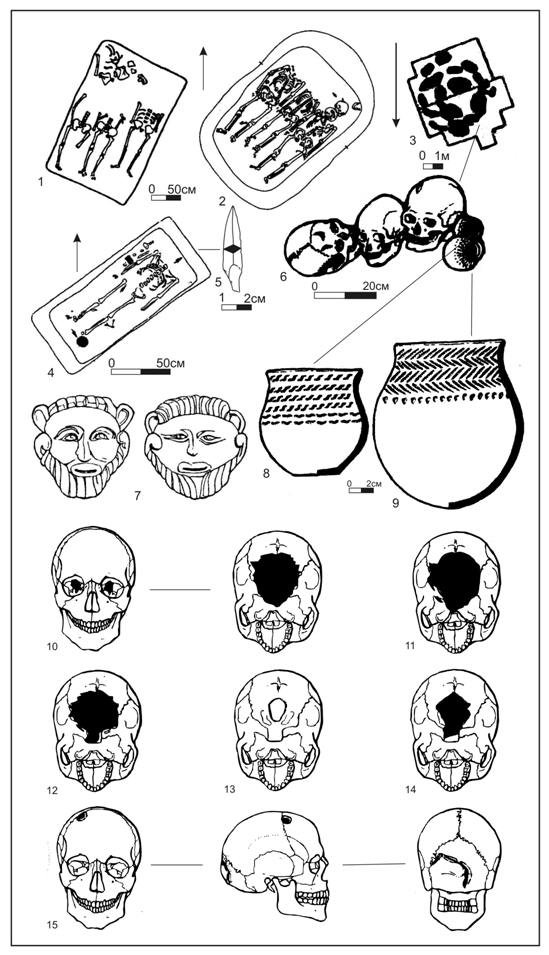
Figure 4 Cut off heads from the burial complexes of the Early Iron Age of the southern part of Western Siberia.
1,2,4: Collective headless depositions from Bystrovka.
2‒5: A deposition without the head, which is replaced by a boney arrowhead, Bystrovka-1 (Burial Mound 4, Grave 3).
3,6,10‒14: Cut off and trepanized skulls (Bystrovka-2, Burial Mound 9).
7: Wooden decorations of the horse bridle from the First Pazyryk Burial Mound.
8: A ceramic vessel of the Kulai archeological culture.
9: A ceramic vessel of the Sargat archeological culture.
15: A trepanized skull.
The skull trepanation of people from the burial mounds of Bustrovka-2,3 was most frequently performed by means of destroying their bases after people’s death. The similar customs are identified during the Early Iron Age on the skulls from the Minusinsk Hollow, Western Mongolia, and Kazakhstan. The authentic marks of such an operation are identified on several skulls from Bystrovka-2 (Burial Mound 9) and Bystrovka-3 (Burial Mound 6). In two burial mounds, there are cases of homogeneous destruction of the base and symmetric damage of the lateral parts of the occipital bones (Figure 4). Nevertheless, one should pay attention to certain differences of these trepanized skulls. First of all, the holes in the skulls have different breaking natures. While the skull from Bystrovka-3 is characterized by the fact that a part of the bone is removed with the help of preliminary drilling and dusting, on all skulls from Bystrovka-2 this operation is performed with a cutting tool without any preliminary marking. Therefore, the trepanation holes from Bystrovka-3 have a more accurate geometrical shape. They are close to a square shape. On the skulls from Bystrovka-2, the similar holes are obviously larger, with uneven ragged edges. The general contour of the broken areas corresponds to ovals. The shape of the trepanation holes (an n-sided polygon) and technology of their creation, i.e. drilling (Bystrovka-3) and breaking and cutting (Bystrovka-2), allow questioning the specific traditions and variants of trepanation in the Upper Ob valley in the Early Iron Age, as well as an individual signature of the operator who performed skull breaking.
The variants of interpretation of the cases of skull trepanation from the Bystrovka necropolis will be quite numerous. First of all, one should mention the fact that the shape and “functional” destination of trepanation holes in the skull bases from Bystrovka-2,3 are quite close to the so-called encephalophagy–eating of the brain of a dead person by his/her relatives. According to the Monte Circeo materials, this custom was popular even with Neanderthals and was preserved up to the ethnographic time by the isolated groups of the population of New Guinea Papuans. Both such actions and efforts to “remove and free” a dead person’s soul may be wide from being the only explanations of the reasons for the skull roof destruction. Obviously, besides its sacral and ritual meaning, the head trepanation of the population that left the Bystrovka necropolis could possess some medical meaning. It is exemplified by the skull from Women’s Deposition 5 (Level 1), Burial Mound 9, Bystrovka-2 with the furunculosis symptoms on the parietal roof and marks of the intravitam occipitalis trepanation. The regeneration of the bone tissue edges testifies to the fact that the woman lived for quite a long time after that complicated operation. In the elite 11th burial mound of the Berelsk necropolis in Gorny Altai, a man’s skull also possessed the marks of a similar head operation. The round cutting of the edges of the occipitalis roof, which had been obviously destroyed by a fall from the horse, was meant to remove the fragments of the skull bones to prevent cerebral edema. However, unlike that operation performed with the materials of the burial mound of Bystrovka-2, this one was not successful.
The identification of authentic signs of trepanation has a very important meaning for the studied topic of ancient violence. Firstly, in some cases actions related to this method can be directly associated with ancient violence. Secondly, sometimes signs of direct military violence are erroneously interpreted as trepanation. On the whole, for the Bystrovka necropolis, depositions with missing heads are often a case. The deposition of a man from Burial Mound 4, Cemetery 1 of Bystrovka-1 is regarded as the most interesting as his head was replaced with a bone point, with its edge upwards. The semantics of this fact can be interpreted in a variety of ways. However, the main idea is represented by replacement of the missing head with an object possessing obviously male, military characteristics. Therefore, according to Herodotus’s description, the Scythian Tsar, Ariant, wanted to learn the number of Scythes and told everyone to bring one bronze arrowhead, from which a spacious ritual vessel (pot?) was cast.
Pictures of cut off heads
In the ancient time, human heads were represented by various decorations. The set of decorations of horse dressing from the burial mounds of Bolshaya Tsimbalka and Chmyreva Mogila contains different combinations of Medusa’s face and a whole array of images including the serpent-footed goddess, Pan, and Heracles. The degree of these images integration into the local environment could be determined by the fact that Scythes described the cases of using the skin stripped off from the human head for horse dressing decoration. The materials of the Siberian Collection of Peter the Great contain a golden earing with a pendant in the form of a human head, which can also be associated with the abovementioned tradition. However, the closest analogy is represented by gilded wooden pendants in the form of five bearded heads on one of the bridles of the First Pazyryk Burial Mound and two more similar decorative pieces on the poitrel; it is interpreted by some researchers as heads of the killed Huns. According to some researchers, the picture of such military trophies is the result of violent Hun and Yuezhi wars of 4th-3rd centuries BC.
Destruction of skulls
Besides scalping marks and cutting of heads, the craniological materials of the Burial Groups of Bystrovka-3,2 testify to numerous cases of artificial destructions of the facial part and brain capsule. Such defects can be classified as both consequences of military injuries and cases of intravitam or postmortem skull damage. Employing the qualitative and quantitative approach to the skull damage analysis suggested by NN Mamontova and M.B Mednikova, one can point out several peculiarities. The marks of military injuries and various destructions are more often a case in the craniological materials of Bystrovka-2 than Bystrovka-3. There are also some qualitative differences recorded. Bystrovka-2 is characterized by cases of the skull part destruction, including absence of the facial skeleton, its fragments, absence of its base. The general distribution of various types of skull destruction among burial mounds and cemeteries also reflects different kinds of posttraumatic damage by the population that left these burial complexes. It is noteworthy that the highest number of solution of continuity of the face and skull base is typical of the skulls from Bystrovka-2 while those buried in Bystrovka-3 are mostly deprived of such defects at all. The character of bone damage on the skulls in both burial mounds is also different. Bystrovka-2 is characterized by injuries inflicted by a cutting object–88.9%, while the occurrence rate of such injuries in Bystrovka-3 is just 40%. The same share is taken by knife wounds. It is interesting that, if classified by the localization of military injuries within the group of similar kinds of damage, damage related to the right halves of the facial part and bones of the skull roof is prevailing. Such regularity is typical of the material of both burial mounds. The prevalence of military injuries in the right halves of the skull brain parts can be determined by left-handedness of those attacking the population that left the burial mounds of Bystrovka-2,3. It is interesting that, if taking into account the northern neighbors of the population that left the Bystrovka necropolis, such a feature is recorded by E.A.Sidorov by the Kulai culture bearers by means of trace evidence analysis (Kamenny Mys-1).
The fierce character of fights also reflects the occurrence of a new type of injuries. They resulted into partial or full skull destruction. Such damage can be determined by adoption of a new kind of weapons. In this connection, the abovementioned prevalence of marks left by cutting objects on the skulls from Bystrovka-2 can hardly be regarded as accidental. The matter is that from 1000 BC to the beginning of 1000 AD the Upper Ob district made up a part of the region where long forms of cutting and stabbing weapons (swords, broadswords) were actively spread. The general “picture” of the military injury rate of the population that left he Bystrovka necropolis is not regarded as unique for the Early Iron Age. In the Western Siberian forest steppe, by the closest neighbors of the Ob valley population–bearers of the Sargat culture, this tendency was also represented quite clearly starting by the last third of 1000 BC. However, taking into account the known “military character” of this culture, the military injury level of the Sargat population is relatively low. The Upper Ob region is characterized by a completely different situation. Taking into consideration a relatively low armament degree of the population (judging by the accompanying burial inventory), the level of the military injury rate is very significant on the whole. Such a peculiarity can serve as a basis for drawing a conclusion concerning gradual extirpation of the Ob region population in the course of military conflicts in the Early Iron Age. The evidence of participation of the ancient population of the southern part of Western Siberia in fierce military fights includes a set of depositions referred to the Late Bronze Age, intermediate period, and Early Iron Age. Not only results of application of various weapons but also their details are clearly preserved on the buried bones.
Injuries inflicted by piercing weapons
On the territory of the Upper Ob region, the skulls of two men from Burial Mound 28, Deposition 1, and Burial Mound 30, Deposition 1 of Novotroitskoe-1 are broken by hatchet hammer. The blows are dealt at the right and left parietal bones (Figure 5). The bone tissue destruction is characterized by clear-cut signs of a blow delivered from top downwards and removal of the spike before the next blow. These lethal injuries could be inflicted in the course of the fight between a horse soldier and dismount warrior. Two more men’s skulls with the holes made by hatchet hammers are known in Burial Mound 10, the cemetery of Biisk-1. Another example of the head destruction with a hatchet hammer is a skull of a man from Tomb 2, Burial Mound 3 of the Tagar Burial Ground (4000-3000 BC) of Beregovoi-116 in the Middle Yenisei region (Figure 5). There are three holes resulted from blows delivered by a piercing weapon located in the parietal part. The hole diameter corresponds to the section of bronze hatchet hammers that were discovered in the burial mounds of Beregovoi-1 (Figure 5). Besides the petroglyphs of Eastern Kazakhstan (Sagyr), the fights with the use of hatchet hammers and head blows delivered by them are depicted in the rock paintings of the Tagar time in the Middle Yenisei region, close to the mountains of Kunya and Tepsei located in the vicinity of the Beregovoi-1 burial group. All these petroglyphs reproduce different stages of fights of dismount warriors with the use of hatchet hammers.
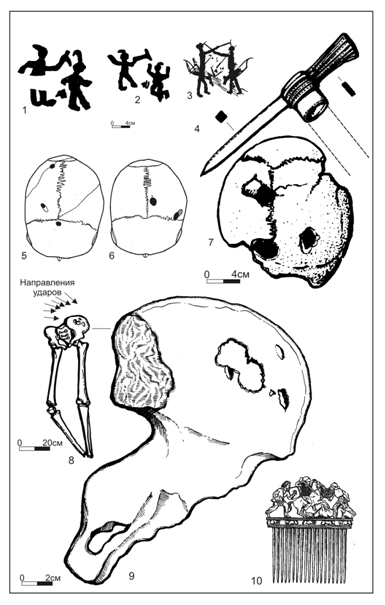
Figure 5 Injuries inflicted by a crush weapon, i.e. a hatchet hammer (the Middle Yenisei region, the Lower Katun region).
1,2: Petroglyphic compositions with the use of hatchet hammers.
1: The Kunya Mount. the Tepsei Mount;
3: Sagyr (Eastern Kazakhstan).
4: a bronze hatchet hammer of the Tagar archeological culture (Beregovoy-1).
5,6: skulls with holes made by hatchet hammers from the Novotroitskoe-1 burial group (Burial Mound 28, Deposition 1, Skeleton 2; Burial Mound 30, Grave 1, Skeleton 1).
7: A skull with the traces of holes made by hatchet hammer from Burial Mound 3, Tomb 2 of the Tagar cemetery of Beregovoy-1.
8: the direction of hits delivered by hatchet hammer at the pelvic bone of the buried person (Chultukov Log-1, Burial Mound 38);
9: a pelvic bone from the northern Pazyryk deposition (Chultukov Log-1, Burial Mound 38).
10: An image of the fight between dismount warriors and a horse soldier on the golden comb from the Solokh burial mound (the Northern Black Sea region).
A whole array of men’s skulls with the holes resulted from hatchet hammer blows is known on the adjacent territory of the Upper Ob region–in Sayano-Altai. Such cases are typical of the Pazyryk depositions of Gorny Altai (the Second Pazyryk Burial Mound, Ulandryk-2), Tuva (Sagly-Bazhi-2), and Western Mongolia (the Ulaangom Burial Ground). All the blows were dealt by hatchet hammer at the parietal area. As mentioned above, such lethal injuries could result from the fight both of two dismount warriors and a horse soldier and dismount warrior. In the latter case, blows could be dealt not only at the head. In particular, there are six blows delivered by hatchet hammer recorded in the Lower Katun region, in the northern Pazyryk deposition (Chultukov Log-1, Burial Mound-38), on the left haunch bone of a man’s skeleton. The blows were delivered one after another. Judging by the location of injuries, the attacker hit the victim from the right. Two blows delivered by hatchet hammer were perforating and could be dealt with a great force. The presence of the evidence of military injuries in the lower part of the buried man’s body can be related to the fact that a dismount warrior attached a horse soldier. This very fight is depicted on the famous golden Scythian comb from the Solokha burial mound in the Northern Black Sea region. The deposition with injuries inflicted by hatchet hammer in the waist area from Chultukov Log-1 dated back to 4000-3000 BC, the time that is synchronous with the “Scythian” picture.
It is noteworthy that in all cases (Novotroitskoe-1, Biisk-1, Beregovoi-1, Chultukov Log-1, the Second Pazyryk Burial Mound, Ulandryk-2, Sagly-Bazhi-2, the Ulaangom Burial Ground), injuries inflicted by hatchet hammer are represented in burial groups, whose accompanying inventory contains these very weapons. The only exemption includes the Bystrovka necropolis (Bystrovka-1,2,3), whose materials encompass hatchet hammers, but no evidence of their application are identified. One still has to define the reasons for this phenomenon. Such a situation may be determined by the fact that the population that left the Bystrovka necropolis was located in the most distant northern periphery of distribution and employment of this kind of weapon. It is also interesting that all the above mentioned burial mounds characterized with injuries inflicted by hatchet hammers possess quite close dating features. It can testify either to the general strengthening of tension in the last quarter of 1000 BC in the south part of Western Siberia and adjacent territories, or to the whole series of local military conflicts resulted from the Macedonian invasion to Asia.
Injuries inflicted by small weapons
The facts of various injuries delivered by small weapons are widely represented in the burial complexes of the Late Bronze Age – Early Iron Age (Figure 6). In Deposition 8, Burial Mound 3 of Ordynsky-1 (the Irmen culture of the Late Bronze Age), there is a bronze two-bladed tanged arrowhead stuck in one of the dorsal vertebras of a man’s skeleton (Figure 6). This heavy wound could cause the death of the buried person. The arrowhead (Figure 6) is a dating object, which is referred to the period not earlier than the 7th century BC. In Deposition 11 (referred to the intermediate time from the Late Bronze Age to the Early Iron Age) of the phreatic burial mound of Blizhnie Elbany-14, there is a bronze two-bladed socketed arrowhead stuck in the condyle of the left thighbone of the skeleton of a man of 40-60 years old and deeply pierced in the epiphysis at the knee level. The arrowhead stuck in the bone dates back to the 7th-6th centuries BC. In the collective deposition of Burial Mound 2, Bystrovka-2 (Deposition 14), there is an iron three-bladed tanged arrowhead stuck close to the right blade bone of a man of 30-35 years old. This object was likely to cause the death of the buried person. The iron arrowhead with a triangular head and blades cut at the right angle is referred to the type of the Sarmat arrowheads, which were widely spread from the 3rd to the 2nd centuries BC. In Pair Deposition No.18, Burial Mound 2, Bystrovka-2, there is a horny, socketed arrowhead split in two with a broken pin and tap discovered in the breakup of the skull of a man’s skeleton. The object was damaged when hitting the head of the buried person. The horny arrowheads of this type date back to the middle of 1000 BC.
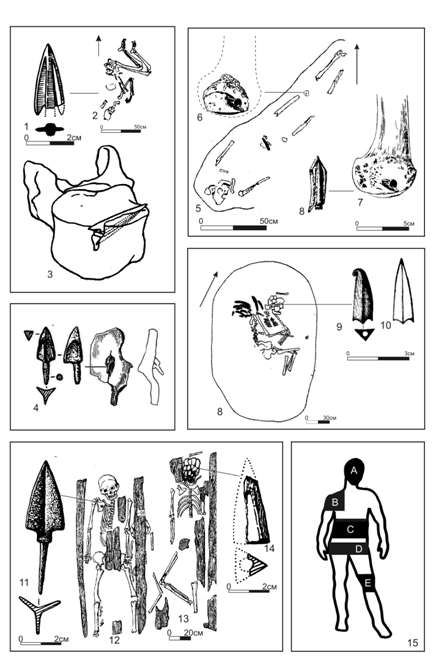
Figure 6 Facts of arrow injuries in the Bronze and Copper Ages (the southern part of Western Siberia).
1‒3: Ordynskoe-1, Burial Mound 3, Deposition 8 (the Irmen culture of the 9th-8th centuries BC).
4: Novotroitskoe-2 (5th-3rd centuries BC).
5‒8: Blizhnie Elbany 14, Deposition 11 (the transition period from the Late Bronze to the Early Iron Age, 7th-6th centuries BC).
9‒11: Bergul-1 (the Novochekino culture of the 4th-3rd centuries BC).
12‒15: Bystrovka-2, Burial Mound 2, Depositions 14,18 (4th-3rd centuries BC). Areas of arrow injuries
Beyond the boundaries of the Upper Ob territory, the facts of hitting the head with an arrow are known in the north of the Barabin forest steppe. In the deposition of Burial Mound 2 of the Bergul-1 cemetery (the Novochekino culture of the Early Iron Age), a bronze socketed arrowhead with a heavily swept spike was discovered inside a woman’s skull. Such a distortion was caused by the impact with the interior surface of the parietal bones of the skull after the arrowhead had broken the base of one of the skull eyeholes and stuck in the interior bone roof of the skull. That shot in the head was obviously lethal for the buried woman. The arrowhead dates back to the 4th century BC.
On the whole, all injuries inflicted by small weapons within the period from the Late Bronze to Early Iron Age are characterized by the highest possible variety of positions. They were targeted at the head (Bergul-1, Bystrovka-2), shoulders (Bystrovka-2), back (Ordynskoe-1), and legs (Blizhnie Elbany-14) of potential victims. All the shots are distinguished by quite a high level of accuracy and strength, so the arrowheads either got into the dense bone tissue (Ordynskoe-1, Blizhnie Elbany-14) or were distorted after contact with it (Bergul-1, Bystrovka-2). Judging by the depth of penetration into soft tissues and bone destruction, all arrow hits were rather heavy and most frequently lethal. These features testify not only to a considerable deadly force of bows but also to the fact of shooting at the poorly defended enemy. Unlike those blows delivered with hatchet hammer, the chronology of burial complexes containing the evidence of arrow injuries is characterized by wider dating (from the first half to the last quarter of 1000 BC). It is most vividly illustrated by a considerable typological variety of arrowheads (bronze, horny, iron, socketed, tanged). This peculiarity is determined by two factors. Firstly, a wider area of small weapon application. Secondly, by rather a limited period of employment of the hatchet hammer as a type of weapons. The main localization of ancient archeological complexes containing evidence of arrow injuries related to the Upper Ob valley is not accidental. During several historic periods, this territory encompassed the features of the transit route and frontier zone. It is here where the facts of armed conflicts with the use of bows and arrows are recorded in very scare and poor written sources even in the 17th-18th centuries. The places of these fights are very close to the location of the abovementioned archeological complexes with the evidence of arrow injuries.
Objects symbolizing weapons
Violence-related weapons, which are frequently regarded as its symbol, sometimes became a decoration, an amulet or a sample for votive products (Figure 7).
Pendants in the form of weapons
Arrowheads
In the Upper Ob region, in the pair deposition (No.22) from the phreatic burial ground of Blizhnie Elbany-7, the pectoral of a young woman included a bead made from a bronze, socketed arrowhead with a broken spike (Figure 7). The deposition is referred to the transition period from the Late Bronze to the Early Iron Age and dates back to no later than the 7th century BC. Certain analogues to this decoration can be found in Central Asia and Iran. The complex waist pendant (Figure 7) from seven bronze two-bladed socketed arrowheads was discovered in Burial Mound 4 of the Saka time cemetery of Aidyn-Kul-3. The elements of the sculpture from Persepolis (Iran) include an image depicting a pendant from five arrowheads tied to a long (leather?) cord.
Bows
The miniature bronze images of bows of the Scythian type (Figure 7) are known from Derbent by Scythes to Aimyrlyg in Tuva. On the territory of Western Siberia, a great number of the similar bronze models of bows is known in the Stepanovskoe “treasure” and Berezovy Mys. They were regarded as attributes of the ancient cult places. According to the materials of the burial complexes of the Upper Ob region (Staroaleika-2), such pendants could be used as fastenings of the sheath. All these items date back to no later than the middle of 1000 BC.
Swords
The miniature bronze dagger cast in the one-sided mould is known in the materials of the cult complex of the transition time from the Late Bronze Age to the Early Iron Age–Zavyalovo-1 on the right bank of the Ob River, to the south of the city of Novosibirsk.17 The total dimensions of the item allow comparing it with votive Tagar daggers of the last third of 1000 BC, but the decoration of the handle and crossguard brings the dagger closer to the samples of the Cimmerian weapons (8th-7th centuries BC). It is this historic period that is characterized with corresponding decoration of items of piercing weapons and their images on deer stones. Another miniature bronze dagger belonged to the Novoobintsevo treasure located on the high bank of the Ob River, to the north of the city of Barnaul. This complex dates back to the 4th-3rd centuries BC. Another miniature bronze dagger from the Upper Ob basin originates from the accompanying inventory of the Maima-4 cemetery on the right bank of the Lower Katun. This burial complex dates back to the 3rd century BC.
Pictures of military conflicts
Military conflicts in the pictures of the Scythian time are regarded as rather a rare plot. For the territory of the south of Western Siberia, one can provide just several examples (Figure 8) from burial complexes (Bashadar, Tepsei-3) and separate decoration elements (the Siberian Collection of Peter the Great). According to some researchers, the zoomorphic decorations of the wooden sarcophagus from the Elite Second Bashadar burial mound (Figure 8) are regarded as picturesque reproduction of battle scenes, in which the military leader buried in it took part intravitam. The figure of a tiger successively overriding a whole set of hoofed animals could convey an image of the military leader who successively “bent to submission or destroyed” various tribal groups represented by the images of a moose, sheep, and boar. The golden items of the Siberian Collection of Peter the Great include an embossed plate depicting “a parade of warriors returning from the campaign”. In our opinion, this composition should be interpreted as persecution of one group of warriors by the other. There are two warriors depicted on the left side of the plate, next to which there are horses with dead warriors’ bodies on their backs. On the right side, there is a group of three horse soldiers riding after them, shooting bows, and stabbing them with spears.
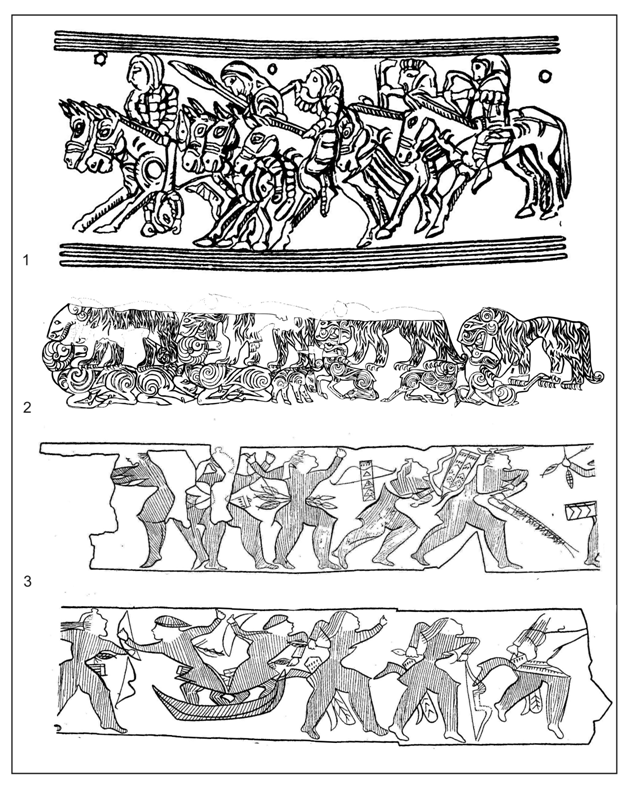
Figure 8 Battle scenes of the Scythian and Hun-Sarmatian time of the southern part of Western Siberia.
A vivid illustration of military conflicts involving both genders is represented by pictures on wooden plaques (Figure 8) [Complex of Archeological Monuments, p. 96] from Tepsei-3 (Tomb 1) in the Middle Yenisei region. A possibility of such events is indirectly confirmed by anthropological materials from burial monuments of the Kokel culture of Tuva and evidence of mass military injuries on male and female skulls in the cemetery of Bystrovka-2 in the Upper Ob region.18
The archeological sources reflecting the sources of violence on the territory of Southern Siberia in the Bronze and Copper Ages are quite various and illustrative. It is related to a number of factors. First of all, to the vicinity of the upper basin to the territory of Central Asia, as a region with the historically established culture of military violence It is also noteworthy that the territory of South Siberia was not such a distant periphery, which was directly affected by the consequences of large-scale military conflicts of ancient times and migration activity of early nomads. The archeological materials related to ancient violence are more versatile and concrete than the quotable ancient descriptions, which frequently resulted from direct observation of those facts. Therefore, the thorough work aimed at summarizing such data within the framework of particular territories and certain historic periods is extremely important for reconstruction of violence traditions within the context of ancient cultures.
None.
None.
Author declares that there is no conflict of interest.

©2020 Borodovskiy. This is an open access article distributed under the terms of the, which permits unrestricted use, distribution, and build upon your work non-commercially.